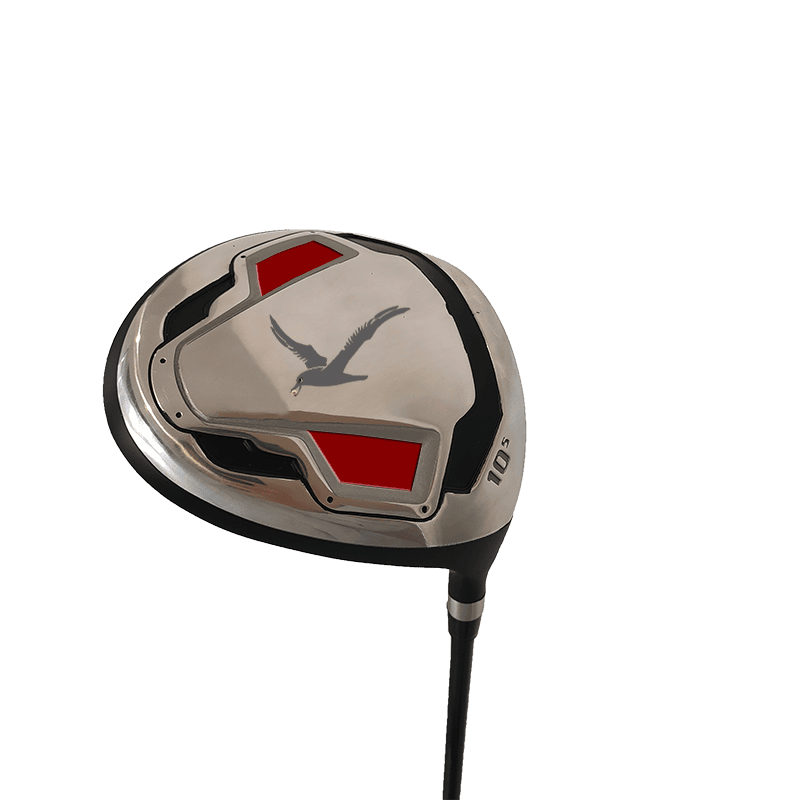
A golf driver’s design directly determines a player’s driving distance, accuracy, and swing experience. With the popularization of golf, club design has shifted from "one-size-fits-all" to "segmented adaptation." In 2024, the custom club market accounted for 45% of total sales, far exceeding ordinary clubs. Professional golf drivers require scientific design across four core dimensions—club head, shaft, grip, and specialized functions—to meet the needs of players at different levels (beginners, intermediates, professionals) and scenarios (driving, approaching the green, putting).

The club head is the core part that affects hitting performance, and it has different designs based on club type:
Woods (for driving): They use "large-volume titanium club heads" (380-460cc capacity), and the sweet spot range is 20% bigger than traditional heads. Even if you hit off-center, you can still keep the distance. Tests show that large-head woods make driving distance longer by 5-8 yards.
Irons (for approaching the green): They are divided into "cavity-back irons" and "blade irons":
Cavity-back models (for beginners) have a low center of gravity and are more forgiving. They reduce hitting deviation by 30%.
Blade models (for professionals) have high accuracy, and they’re good for controlling the ball’s path.
Putters: They focus on "high MOI (Moment of Inertia)". This reduces the club head from twisting when putting, and lowers putt deviation by 25%.
Shaft design must match a player’s swing speed and strength correctly:
Flex rating: It’s divided into L (Light), R (Regular), S (Stiff), X (Extra Stiff). Beginners (swing speed <85mph) are good with L/R flex. This helps them avoid poor control from shafts that are too stiff. Professionals (swing speed >105mph) choose S/X flex. This lets them transfer more power.
Shaft weight: It’s kept between 45-120g.Lightweight shafts (45-60g) increase swing speed by an average of 5-7mph; heavy shafts (90-120g) enhance stability.
Length: Adapted to height. For players 170cm tall, the recommended wood length is 114-116cm—excessive length easily distorts the swing, reducing hitting accuracy by 15%.
Grip design affects control and comfort during swings:
Material:
Rubber grips (excellent anti-slip performance, suitable for rainy conditions).
PU grips (soft feel, strong sweat absorption).
Surface texture depth of 0.3-0.5mm enhances friction, reducing swing slippage by 40%.
Size: Selected based on palm circumference (Small: <19cm, Medium: 19-21cm, Large: >21cm). Improper size easily causes wrist force imbalance, increasing putt deviation by 30%.
Shock absorption: Some grips add "shock-absorbing foam" to reduce hand vibration during hits, lowering wrist fatigue by 28% with long-term use (based on fatigue rating).
Driving woods have "aerodynamic grooves" added. These grooves reduce wind resistance (the wind resistance coefficient went down by 12%), and this makes swing speed faster.
Iron faces use "high-rebound materials" (the rebound coefficient is 0.83-0.86, and it meets USGA standards). This increases hitting distance by 3-5 yards.
Putter faces have "micro-concave texture" (the texture spacing is 0.2mm). This texture enhances ball rolling stability, and this makes hole-in rates better by 18%.
Weight adjustment: Some clubs have built-in "weight adjustment modules." Players can adjust the club head’s center of gravity by adding or removing 5-10g weights. This helps them adapt to different green speeds.
| Design Dimension | Core Features | Target Players/Scenarios | Measured Effect |
|---|---|---|---|
| Club Head | Large titanium woods; cavity-back/blade irons | Woods: All players; Irons: Cavity (beginners), Blade (professionals) | Woods: +5-8 yards; Irons: -30% deviation |
| Shaft Parameters | L/R flex (beginners); 45-60g weight (speed boost) | Beginners: L/R flex + lightweight; Pros: S/X flex + heavyweight | +5-7mph swing speed; +25% stability |
| Grip Adaptation | Rubber/PU material; size by palm circumference | Rainy: Rubber; Sweat-prone: PU; Size: All players | -40% slippage; -28% fatigue |
| Specialized Functions | Wind-resistant grooves (woods); micro-concave texture (putters) | Driving: Woods; Green: Putters | Woods: -12% wind resistance; Putters: +18% hole-in rate |
Currently, golf driver design is evolving toward "intelligence + customization":
Clubs equipped with sensors can collect real-time swing data (speed, angle) to assist in design optimization.
Sales of 3D-printed custom club heads (adapted to individual swing paths) grew 60% year-on-year.
By accurately grasping design essentials and choosing a club that fits one’s needs, players at all levels can improve their hitting performance by 15%-30%—making it a key driver for enhancing golf skills.